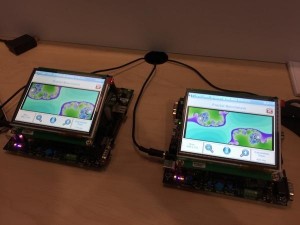STMicroelectronics performed a benchmark comparison of the STM32F756NG MCU, built around the recently announced ARM Cortex-M7 core, with ST’s own STM32 F4 (32-bit Corex-M). Attendees saw anywhere between a 30 percent to 70 percent faster processing speed during the booth demo. Officially, the company notes that the device delivers up to twice as much processing and DSP performance. The STM32 F7 series operates at frequencies up to 200 MHz and uses a six-stage superscalar pipeline and Floating Point Unit to produce up to 1000 CoreMarks. Interestingly, power efficiency is not impacted. The new series’ Run mode and low-power modes (STOP, Standby, and VBAT) consume current at the same low levels as the STM32 F4: 7 CoreMarks/mW in Run mode; and, for low-power modes, down to 120 uA typical in STOP mode with all context and SRAM content saved, and 1.7uA typical in STANDBY mode and 0.1uA typical in VBAT mode.


Honestly, I don’t really know much about ARM and its mbed OS. But based on what you mentioned that it is designed to reduce energy consumption (low power energy), I feel that this surely is something that would benefit the IT industry and business in general. Not only would companies be able to save on energy costs, they also would be able to maximize the features of this operating system. I will be reading more about ARM and mbed OS for additional learning. Thanks.